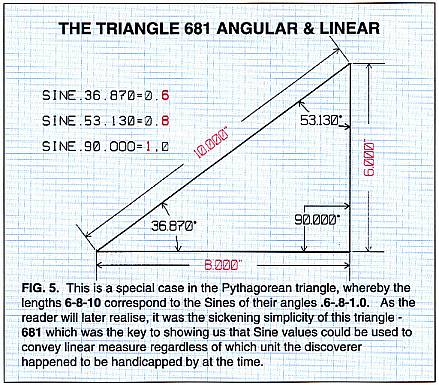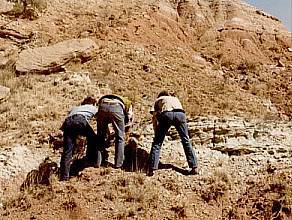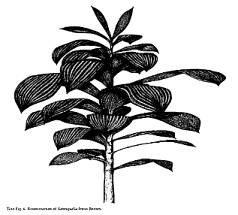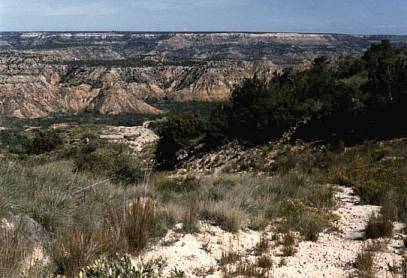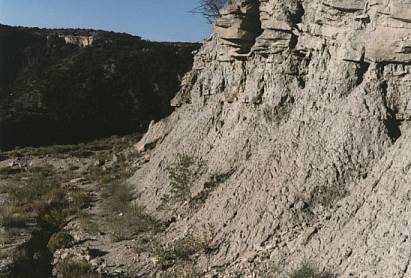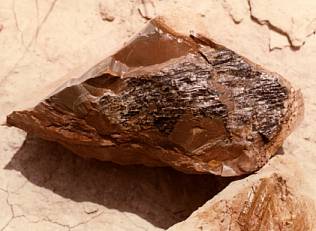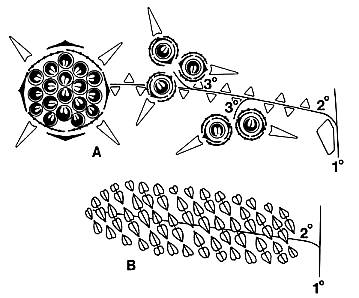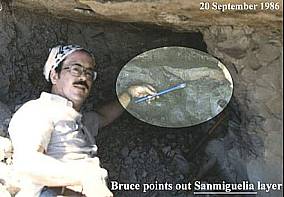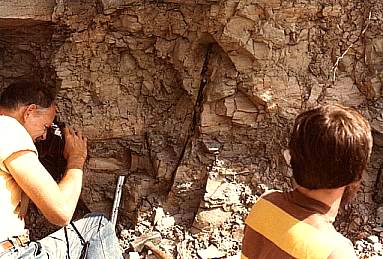Esoteric Notes
SINE/SIGN 681
Wood and Campbell (1994) determined that 681 referred to a special case in the Pythagorean triangle, whereby the lengths 6-8-10 correspond to the Sines of their angles, i.e. .6-.8-1.0 (see excerpt from SINE LANGUAGE). This triangle - 681 - which was the key to showing that Sine values can be used to convey linear measure regardless of which unit the discoverer was handicapped by at the time. It was a simple formula for remembering and determining Sines. But one important number was missing that makes it clear it is a reference to a right angle triangle: 9 (90). If put in order to distinguish the hypotenuse from the sides of the triangle, the sequence would be 6891, where 6 and 8 represent the sides, and 1 (10) represents the hypotenuse.
|
What could 6891 signify other than a clever reference to a special Pythagorean case? In the cryptic message that contains this code, 681 is preceded by PAX, which is French for PEACE (see excerpt from GeneSet).
A quotation from a gravestone in the churchyard of St Mary Magdalen at Rennes-le-Château reads in French:
"BERGERE, PAS DE TENTATION QUE POUSSIN,
TENIERS, GARDENT LE CLEF,
PAX 681...."
Translation:
"SHEPHERDESS, NO TEMPTATION, THAT
POUSSIN, TENIERS, HOLD THE KEY,
PEACE 681"
A transliteration of this message could be:
"ISIS, DO NOT TEMPT US, BECAUSE
POUSSIN AND TENIERS GUARD THE KEY,
PEACE 681"
In the church of St Mary Magdalen at Rennes-le-Château a quotation from under the frieze which displays Jesus on a hillside on the west wall of the church reads in French:
"PAR CE SIGNE TU LE VAINCRAS"
Translation:
"BY THIS SIGN YOU WILL WIN/CONQUER IT"
except the word 'le' - meaning 'he' or 'it' - has been added or inserted, changing the sense of the phrase from its original meaning. But what does IT refer to? Conquer, win, overcome, surmount, solve, figure IT out? What does SIGN mean? What is the SIGN? Doesn't this phrase refer to the CROSS as the SIGN, and what it symbolizes?
What could PEACE 68[9]1 mean? Is PEACE 681 what IT is about? Could it also be a SIGN, or is it the SINE by which we can figure IT out? In other words, BY THE CROSS YOU WILL FIGURE PEACE 681 OUT.
Perhaps the sequence of numbers was intentionally changed so that IT is disguised or hidden.
From Saturn: Source of Measure, Mr. Pietsch shows how Saturn rings true.
"As we might suspect, Saturn dramatically demonstrates the pervasiveness of the Golden Proportion in our solar system. Known as Phi, 1.618122977 or .618, the Golden Proportion is the framework origin of all Nature.
"Though only an abstraction, it is through comparison with this mean, that we establish the individuality of any natural event or living geometry. The identity of a plant for example, is recognizable by its individual adaptation to or departure from the Golden Mean — Nature's guarantee of individuality within the law.
"Numerically, the Golden Number is expressed as the minutes in Saturn's rotational day, 618. Geometrically it is exemplified on a planetary level by the conjunction period of Saturn and Jupiter. Every twenty years or so, Saturn conjuncts with Jupiter at the phi point or .618 mark of its orbit. In other words, when Jupiter completes one revolution around the Sun plus .618 of its next 360 orbit, it is closely aligned or conjunct with Saturn. From Earth we see Jupiter and Saturn together in the heavens. After twenty more years we will again see them close in the sky but advanced about 222 degrees or the phi proportion of the orbital circuit of the heavens."
3168 and the LORD JESUS CHRIST
(Donald B. Ratsch, http://www.100megsfree4.com/farshores/oberg.htm)
"A newly released book that is sure to rock the Geometry, religious, space and mathematics worlds concerns the number, 3168, a number that is manifesting itself throughout all creation and the universe and is associated with Jesus Christ. In the book, "Jesus Christ the Number of his Name" by Bonnie Gaunt has nothing to do with the bible code we have all heard about. Simply put, when using the Greek alphabet in which each letter has a numerical value, the word "LORD" has a numerical value of 800, that is, Kappa=20, Upsilon=400, Rho=100, Iota=10, Omicron=70 and Sigma=200. Adding all those sum up to 800. Using the same Greek alphabet and their numerical values for the name "JESUS" sums up to 888 and finally the same method for the "CHRIST" sums up to 1480. When adding up all three,
Lord = 800
Jesus = 888
Christ = 1480
---- TOTAL 3168"
From "A Propos du nombre 3168" (http://perso.respublica.fr/bibleetnombres/nomb3168.htm)
3168 = |
[3] 3 + [1] 3 +[6] 3 + [8] 3 |
|
27 + 1 + 216 + 512 |
= 756 | |
75 6 = |
[7] 3 + [5] 3 +[6] 3 |
|
343 + 125 + 216 |
= 684 | |
684 = |
[6] 3 + [8] 3 +[4] 3 |
|
216 + 512 + 64 |
= 792 | |
792 = |
[7] 3 + [9] 3 +[2] 3 |
|
343 + 729 + 8 |
= 1080 | |
1080 = |
[1 + [0] 3 +[8] 3 + [0] 3 |
|
1 + 0 + 512 + 0 |
= 513 | |
513 = |
[5] 3 + [1] 3 +[3] 3 |
|
125 + 1 + 27 |
= 153 | |
153 = |
[1] 3 + [5] 3 +[3] 3 |
|
1 + 125 + 27 |
= 153 |
Other websites on the subject
of 3168:
http://perso.respublica.fr/bibleetnombres/nomb3168.htm
http://www.greatdreams.com/eclipse.htm
http://www.makecashonline.com/links.htm
http://www.bibleetnombres.online.fr/almanach.htm
Another Possibility for Peace 681
When the numbers are added, 3 + 1 + 6 + 8 = 18, and 1 + 8 = 9. The two numbers 18 and 9 become part of the solution. 18 is the number of Isis, and 9 represents the end of a cycle (0-9). Also, 1 + 5 + 3 = 9
Could the answer be found in the reverse/mirror of 1986? If so, why eliminate the 9? Because there is more in the code than just a year, and the missing (hidden) 9 could be figured out based on geometry and the missing 3 (for Trinity?). How about the month and the day? The reverse/mirror of 681 is 186, which in European notation means 18/6 (day followed by month) or 18 June (which just so happens to be Bonnie's birthday). As 618 (phi), one has the American notation for June 18. Therefore PEACE 68[9]1 could be a reference to 18 June 1986. All I am doing is exploring possibilities.
And what is significant about that date? Bonnie and Bruce Cornet were married on that date, and Bonnie Cornet translates to Vesica Piscis using UHA. So why would Poussin and Teniers make reference to a date in the future, especially the date of a marriage? If so, what godly importance could there be to such a marriage? PEACE? What peace? The missing peace/piece to the puzzle? I'll let you figure it out.
Perhaps you are looking too hard for the answer. Perhaps it is staring you in the face. Either all of these clues, synchronicities, and revelations are folly and the fodder of dementia, or they are the key to unlocking the most important mystery of the Universe. Are we alone? And if we are NOT alone, who IS with us?
Let me give you one last clue, a lesson (parable) about Evolution and Creation based on a true story. The story is relevant, because it involves the discovery of a fossil plant named Sanmiguelia (Spanish after Saint Michael) in Sunday Canyon, Texas, during the Easter week of 12 April 1980.
A MOST UNUSUAL CLUE
During the Easter week of 12 April 1980 Bruce Cornet took a week-long vacation from his job at the Gulf Reseach & Development Company in Houston, TX, in order to join two other paleontologists on a trek across the Dockum basin in west Texas. He joined up with Phil Murray and Al Santa Luca in Rankin, Texas, for a bone hunt at various fossil reptile and fish localities in Late Triassic age rocks of Texas. The Triassic rocks are exposed from Howard County in southwestern Texas all the way north to Palo Duro Canyon in the Texas panhandle.
|
Their plan was to work their way north, and reserve two days near the end of the week for exploring the Trujillo Formation in Sunday Canyon, which was a subsidiary canyon off of Palo Duro State Park. On the north wall of Sunday Canyon Sid Ash had discovered the first leaf fossils of the enigmatic plant, Sanmiguelia lewisii, with organic tissue preserved. This was an important discovery, because without organic material they had little hope for recovering well-preserved organic structures. Impression fossils preserve only the outer morphology (shape) of the organism. Cornet wanted to find reproductive organs well enough preserved that he could correctly interpret their internal structure and external morphology, as well as their affinity (relationship) to known plants. Why is this important? Taxonomic relationships of seed plants, and Sanmiguelia was a seed plant, are based almost entirely on the different kinds of reproductive structures in plants. What does that have to do with linking Evolution to religion? Continue reading.
Sanmiguelia was originally discovered by R.W. Brown in the 1950s in Utah. In his 1956 publication on this plant, Brown interpreted it as a primitive palm. Sanmiguelia had been dated as Late Triassic in age both in Utah and Texas where specimens had been found, which made it about 100 million years older than the oldest fossils accepted as examples of the earliest flowering plants (angiosperms). Since then various researchers have expressed their opinions, and none agreed with Brown that Sanmiguelia was a flowering plant or angiosperm, let alone a palm (an advanced type of Monocot). In the 1970s Tidwell and his students revisited one of Brown's collecting localities, and found new and better specimens preserved as leaf and stem casts in siltstone where the plants had been buried in growth position. This is unusual as fossil plants go, but even with this additional information Tidwell could not demonstrate conclusively that Sanmiguelia belonged to the angiosperms, even though it superficially looked like one (actually more like a Lily plant).
|
All major groups of living plants are known as fossils. The study of the evolutionary history of these groups is the subject of paleobotany, but only the origin and early history of flowering plants remain a mystery. There are many botanists and paleobotanists today who will tell you differently. Most will tell you that the oldest or earliest angiosperms date back only to the Early Cretaceous Period, about 120 million years ago. This is only partly true: The oldest fossils accepted as true angiosperms date back to this period of time, and they do not look significantly different from some living angiosperms. Other paleobotanists will tell you that the fossil record is incomplete, and that the earliest history of the flowering plants is missing or poorly preserved. They will also tell you that the evolution of Cretaceous angiosperms represents only the latter half of angiosperm history, and that the earliest Cretaceous angiosperms are still too much like living angiosperms to be the first angiosperms.
The problem of resolving this mystery goes back at least as far as Darwin, and despite attempts to resolve it during the past two decades, there are still too many pieces of the puzzle missing for scientists to be certain about anything regarding the origin of the most important group of plants on earth. In fact, the sudden appearance of angiosperm leaves in the mid-Cretaceous, leaves which at first glance appeared to be nearly fully evolved modern types, was initially interpreted to mean that the fossil record did not preserve the early history of flowering plant evolution. When paleobotanists could not produce convincing fossils of pre-Cretaceous angiosperms to support that interpretation, botanists were faced with a dilema: Angiosperms evolved either by extremely rapid evolution or by Creation. And you guessed it: Scientists chose the Punctuated Equilibria model for Evolution over Creation.
After arriving at the top of the cliff overlooking Sunday canyon, the Triassic Trio parked the pickup truck rather than try to negotiate the gully-eroded dirt road that wound down a 500 foot wall to the bottom of the canyon.
|
Because it was nearly dusk, they decided to pitch camp and start work the next day. They set up their tent on a ledge about one third of the way down the cliff. It was a beautiful vista, but nighttime temperature would get cold enough to freeze their water. Soon after setting up camp, Cornet took a hike up the side of the cliff along the dirt road looking for fossils. He only got a sense of where he would begin to dig the next morning before the Sun Set.
|
The next day they got an early start. Phil and Al decided to venture down to the canyon floor looking for reptile bones. Cornet spent the entire day picking at outcrops along the side of the road. He quickly found specimens of Sanmiguelia similar to those that Ash had found previously in Sunday Canyon. He saw that there was not only vein material preserved, but traces of leaf cuticle as well. Yet these fragmentary specimens, which were found as rubble along the side of the road, would add little knowledge to that which already existed. At least he had found Ash's locality, he thought, but by day's end he became discouraged about the prospect of finding any preserved reproductive organs.
|
The second day Cornet broadened his search, thinking that he might have better luck in another location along the outcrop. He found other types of fossil plants, but no specimens of Sanmiguelia. Later that afternoon he ventured down to the canyon floor and climbed the cliffs on other sides of the canyon. He found nothing there either. As evening approached, he returned to the outcrop where the only specimens of leaves had been found, and tried once again. This time he made several digs into the cliff face, but found nothing of interest. He was thinking of giving up the search, if for no other reason than the day was coming to an end, and they would be breaking camp for home the following morning.
Dinner was a somber event for Cornet. The Trio made light of their disappointment, and considered what they had already collected at other localities and what they had learned. But Cornet was disappointed nevertheless. After cleaning the dinner pans and utensils, Cornet went into the back of the tent to be alone. He began praying. It seemed important for him to reach out for spiritual support and guidance. After all, he had taken a big chance by looking for fossil evidence that would challenge the ruling paradigm in paleobotany, evidence which might prove that the best minds in science had let their personal prejudices cloud their objective judgement. He felt that the success he had had in discovering other angiosperm-like fossils in Triassic rocks was no accident. He had come to believe that there is no one so blind as he who does not want to see, and that by looking for answers with an open mind he would see things others did not or could not see. He reached out to his spiritual leader, and asked Jesus point blank: "If God created life on earth and man via Evolution [that which can be understood] rather than by Divine "magic" [that which can never be understood], and if you want me to know that there is no conflict between the theories of Evolution and Creation, please give me a sign. I came here with the belief that you were guiding me, and that you wanted to show me how faith and persistence work together as one."After finishing his prayer he got up and went outside, where he met Phil and Al, who were sitting under the porch part of the tent waiting for him. He said to them, "Let's give it one last try before it gets dark." Phil agreed, and they all grabbed their hammers and pickaxes, and climbed up to the outcrop. As they got there the Sun was beginning to Set, and long shadows grew everywhere. Al brought along one of the lanterns, saying that they might need it. Phil asked Cornet where to start digging. He walked across the dirt road to the cliff and pointed to an area just under a ledge of sandstone. He had no idea why he chose that area over any other, but it "felt right." The sandstone rested on top of claystone and siltstone beds representing a shallow lake deposit on an ancient floodplain. He wanted to dig, but something told me to give the pickax to Phil, and to step back out of the way. This is important: He listened to his inner feelings, and he gave the task of making the discovery to Phil. He philled his cup!
The Sun was setting rapidly, and Cornet had his heart in his mouth as he watched Al bring the lantern up close to the outcrop to give Phil some light in the shadows of the exposure. He felt that he was giving up his freewill by putting the outcome in the hands of others. Phil asked him where to start, and he just pointed at the outcrop with no particular place in mind. As Phil raised the pickax Cornet felt a giant sense of expectation fall to resignation, and he said to himself, "Here goes nothing," and everything. The pickax sunk into the light gray clay and pieces of rock spilled out of the gash onto the roadside. Nothing. He raised the pickax again for a better swing, and the tip of the pick sunk deep into the outcrop. He levered the pickax to pry out a large chunk of rock. It fell to the roadside, along with other fragments.
In the light of the lantern Cornet saw something. Phil raised the pickax for another swing, but Cornet yelled for him to stop. He then kneeled down to take a closer look at the pieces on the ground, and realized there was something important exposed on the surfaces of those rocks. A closer look revealed an entire reproductive axis. His heart took a sudden jump, and he felt this pressure explode in his chest as the reality of what had just happened sunk in, like the pickax. With several more swings several more reproductive organs fell out, some of which appeared to be flowers.
|
By the time it was totally dark and they had to quit for the night, Cornet was able to go to sleep knowing that his prayer had been answered. Without having prepared the specimens to know for sure what they had discovered, he knew in his heart what they had found. The synchronicity between his prayer and what they discovered was too great, considering that it was their last try in the last rays of sunlight on the last day.
Key words and phrases: Sunset (Hor-em-Akhet), last try, last rays of sunlight, last day, Phil [fill], Mur-ray, Al [all], Santa [ex-Satan], Luca [as in lucent], Saint Michael [Sanmiguelia], Sunday Canyon, Easter week, palm-like fossil.
|
As further excavation in the following months proved, the Triassic Trio had discovered an entire colony of Sanmiguelia plants preserved in growth position, complete with leaves, stems, roots, flowers, pollen, and seeds (see Cornet, 1989).
|
And yet Cornet had dug in that very same spot the day before and found nothing. Was it because the fossils were more deeply hidden, and he had not tried hard enough to find the truth? The meaning behind these events will surely be interpreted differently by skeptics (those whose eyes are closed), but for Cornet it was an answer to prayer and his first real lesson of faith in destiny.
All pages Copyright B.Cornet 2001
Date last updated:
08/26/2021
Contact information:
mailto:cornetbruce@yahoo.com
